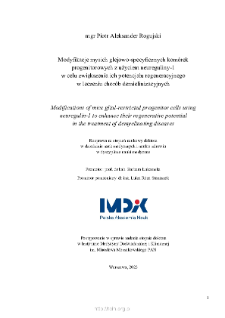
Obiekt
Tytuł: Modyfikacje mysich glejowo-specyficznych komórek progenitorowych z użyciem neureguliny-1 w celu zwiększenia ich potencjału regeneracyjnego w leczeniu chorób demielizacyjnych
Współtwórca:
Łukomska, Barbara (Promotor) ; Stanaszek, Luiza Róża (Promotor pomocniczy)
Wydawca:
Instytut Medycyny Doświadczalnej i Klinicznej im.M. Mossakowskiego PAN
Miejsce wydania:
Uzyskany tytuł:
Stopień studiów:
Dyscyplina :
Abstrakt:
Celem moich badań była weryfikacja hipotezy zakładającej, że nadekspresja neureguliny-1 w glejowo-specyficznych komórkach progenitorowych (GRPs) zmienia ich właściwości funkcjonalne, które mogą być istotne dla zwiększenia potencjału zastosowania GRPs w terapii chorób związanych z demielinizacją. Przedmiotem prowadzonych przeze mnie badań były GRPs izolowane z tkanki nerwowej płodów myszy (mGRPs). Modyfikacje genetyczne mGRPs w celu wywołania nadekspresji neureguliny1 typu I (NRG-1 typu I) przeprowadzone zostały poprzez transdukcję komórek wektorami lentiwirusowymi kodującymi NRG-1 typu I. Badania dotyczyły analizy poziomu ekspresji NRG-1 w zmodyfikowanych mGRPs, ich fenotypu, oraz właściwości funkcjonalnych mGRPs-NRG-1 in vitro. Ocena mGRPs transdukowanych wektorem pLenti-GIII-CMV-NRG-1 typ I-mCherry (NRG-1 typ I) wykazała, że komórki te w kolejnych próbach transdukcji prezentują zróżnicowany poziom syntezy transkryptu dla NRG-1 typu I, a ich dalsza hodowla skutkuje spontanicznym odklejaniem się komórek od powierzchni naczynia hodowlanego i ich śmiercią. Negatywne wyniki transdukcji mGRPs wektorem pLenti-GIII-CMV-NRG-1 typ I-mCherry skłoniły mnie, aby w kolejnym etapie badań zastosować do transdukcji mGRP wektor HIV-SFFV-NRG1 typ I-IRES-mRFP, kodujący sekwencje NRG-1 typu I i fluorescencyjne białko reporterowe mRFP, przedzielone sekwencją IRES (ang. Internal Ribosome Entry Site, wewnętrzne miejsce wiązania rybosomu), umożliwiającą ko-ekspresję obydwu sekwencji pod kontrolą transkrypcyjną wspólnego promotora, lecz z niezależnie zachodzącą translacją. W kolejnym etapie badań podjąłem próbę transdukcji mGRPs lentiwirusowymi cząstkami aktywacyjnymi, zaprojektowanymi w celu nadekspresji endogennego genu kodującego NRG-1 (NRG1-LAPs). Jednak, jednoczesna transdukcja mGRPs trzema wektorami lentiwirusowymi wchodzącymi w skład systemu NRG-1-LAPs, okazała się nieskuteczna. W związku z tym próba wywołania w mGRPs nadekspresji endogennej NRG-1 poprzez transdukcję komórek lentiwirusowymi cząstkami aktywacyjnymi nie powiodła się. Wobec niepowodzeń związanych z modyfikacjami genetycznymi mGRPs w kierunku nadekspresji NRG-1, postanowiłem przeprowadzić dodatkowe badania, oparte na stymulacji mGRPs egzogennym rekombinowanym peptydem neureguliną-1 z myszy (rmNRG-1), poprzez suplementację nim standardowej pożywki, w której hodowano komórki. Suplementacja mGRPs peptydem rmNRG-1 miała zróżnicowany wpływ na fenotyp komórek w hodowli in vitro. Na podstawie przeprowadzonych badań można sformułować następujące wnioski: - nadekspresja NRG-1 typu I, wywołana poprzez transdukcję mGRPs wektorami lentiwirusowymi, powoduje spadek tempa wzrostu tych komórek i stymuluje ich różnicowanie w kierunku 2 oligodendrocytów, nie stwierdziłem jednak istotnego wpływu nadekspresji NRG-1 typu I na właściwości mielinizacyjne mGRPs - moje wstępne badania dotyczące stymulacji mGRPs egzogennym rekombinowanym peptydem neureguliną-1 sugerują zwiększoną proliferację i spowolnienie migracji suplementowanych mGRPs, przy jednoczesnym spadku zdolności tych komórek do różnicowania w dojrzałe oligodendrocyty - wyniki badań przedstawionych w mojej rozprawie doktorskiej wskazują, że wpływ neureguliny-1 na właściwości funkcjonalne mGRPs jest zależny od zastosowanego układu doświadczalnego.
Szczegółowy typ zasobu:
Format:
Identyfikator zasobu:
Źródło:
Język:
Język streszczenia:
Prawa:
Licencja Creative Commons Uznanie autorstwa 4.0
Zasady wykorzystania:
Zasób chroniony prawem autorskim. [CC BY 4.0 Międzynarodowe] Korzystanie dozwolone zgodnie z licencją Creative Commons Uznanie autorstwa 4.0, której pełne postanowienia dostępne są pod adresem: ; -
Digitalizacja:
Instytut Medycyny Doświadczalnej i Klinicznej im. M. Mossakowskiego Polskiej Akademii Nauk
Lokalizacja oryginału:
Biblioteka Instytutu Medycyny Doświadczalnej i Klinicznej im. M. Mossakowskiego PAN
Dofinansowane ze środków:
Dostęp:
Kolekcje, do których przypisany jest obiekt:
- Repozytorium Cyfrowe Instytutów Naukowych > Kolekcje Partnerów > Instytut Medycyny Doświadczalnej i Klinicznej PAN
- Repozytorium Cyfrowe Instytutów Naukowych > Kolekcje Partnerów > Instytut Medycyny Doświadczalnej i Klinicznej PAN > Prace dyplomowe > Prace doktorskie
- Repozytorium Cyfrowe Instytutów Naukowych > Piśmiennictwo > Prace dyplomowe
Data ostatniej modyfikacji:
14 gru 2023
Data dodania obiektu:
14 gru 2023
Liczba pobrań / odtworzeń:
187
Wszystkie dostępne wersje tego obiektu:
https://rcin.org.pl./publication/276356
Wyświetl opis w formacie RDF:
Wyświetl opis w formacie RDFa:
Wyświetl opis w formacie OAI-PMH:
Obiekty Podobne
Jurga, Marcin
Habich, Aleksandra
Bużańska, Leonora
Andrzejewska, Anna
Drela, Katarzyna
Podobińska, Martyna.

 INSTYTUT ARCHEOLOGII I ETNOLOGII POLSKIEJ AKADEMII NAUK
INSTYTUT ARCHEOLOGII I ETNOLOGII POLSKIEJ AKADEMII NAUK
 INSTYTUT BADAŃ LITERACKICH POLSKIEJ AKADEMII NAUK
INSTYTUT BADAŃ LITERACKICH POLSKIEJ AKADEMII NAUK
 INSTYTUT BADAWCZY LEŚNICTWA
INSTYTUT BADAWCZY LEŚNICTWA
 INSTYTUT BIOLOGII DOŚWIADCZALNEJ IM. MARCELEGO NENCKIEGO POLSKIEJ AKADEMII NAUK
INSTYTUT BIOLOGII DOŚWIADCZALNEJ IM. MARCELEGO NENCKIEGO POLSKIEJ AKADEMII NAUK
 INSTYTUT BIOLOGII SSAKÓW POLSKIEJ AKADEMII NAUK
INSTYTUT BIOLOGII SSAKÓW POLSKIEJ AKADEMII NAUK
 INSTYTUT CHEMII FIZYCZNEJ PAN
INSTYTUT CHEMII FIZYCZNEJ PAN
 INSTYTUT CHEMII ORGANICZNEJ PAN
INSTYTUT CHEMII ORGANICZNEJ PAN
 INSTYTUT FILOZOFII I SOCJOLOGII PAN
INSTYTUT FILOZOFII I SOCJOLOGII PAN
 INSTYTUT GEOGRAFII I PRZESTRZENNEGO ZAGOSPODAROWANIA PAN
INSTYTUT GEOGRAFII I PRZESTRZENNEGO ZAGOSPODAROWANIA PAN
 INSTYTUT HISTORII im. TADEUSZA MANTEUFFLA POLSKIEJ AKADEMII NAUK
INSTYTUT HISTORII im. TADEUSZA MANTEUFFLA POLSKIEJ AKADEMII NAUK
 INSTYTUT JĘZYKA POLSKIEGO POLSKIEJ AKADEMII NAUK
INSTYTUT JĘZYKA POLSKIEGO POLSKIEJ AKADEMII NAUK
 INSTYTUT MATEMATYCZNY PAN
INSTYTUT MATEMATYCZNY PAN
 INSTYTUT MEDYCYNY DOŚWIADCZALNEJ I KLINICZNEJ IM.MIROSŁAWA MOSSAKOWSKIEGO POLSKIEJ AKADEMII NAUK
INSTYTUT MEDYCYNY DOŚWIADCZALNEJ I KLINICZNEJ IM.MIROSŁAWA MOSSAKOWSKIEGO POLSKIEJ AKADEMII NAUK
 INSTYTUT PODSTAWOWYCH PROBLEMÓW TECHNIKI PAN
INSTYTUT PODSTAWOWYCH PROBLEMÓW TECHNIKI PAN
 INSTYTUT SLAWISTYKI PAN
INSTYTUT SLAWISTYKI PAN
 SIEĆ BADAWCZA ŁUKASIEWICZ - INSTYTUT TECHNOLOGII MATERIAŁÓW ELEKTRONICZNYCH
SIEĆ BADAWCZA ŁUKASIEWICZ - INSTYTUT TECHNOLOGII MATERIAŁÓW ELEKTRONICZNYCH
 MUZEUM I INSTYTUT ZOOLOGII POLSKIEJ AKADEMII NAUK
MUZEUM I INSTYTUT ZOOLOGII POLSKIEJ AKADEMII NAUK
 INSTYTUT BADAŃ SYSTEMOWYCH PAN
INSTYTUT BADAŃ SYSTEMOWYCH PAN
 INSTYTUT BOTANIKI IM. WŁADYSŁAWA SZAFERA POLSKIEJ AKADEMII NAUK
INSTYTUT BOTANIKI IM. WŁADYSŁAWA SZAFERA POLSKIEJ AKADEMII NAUK


































